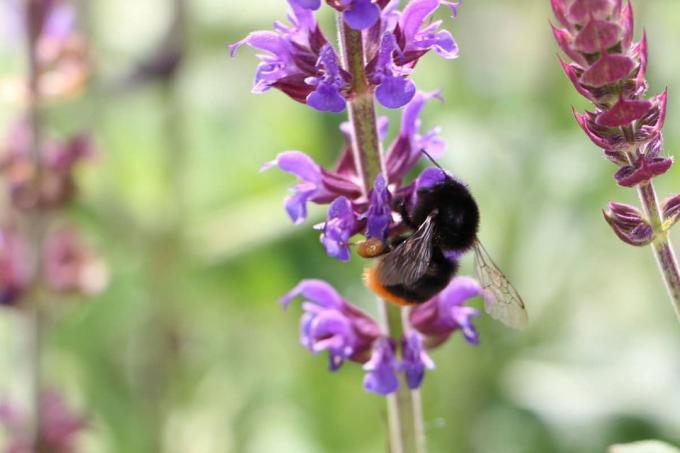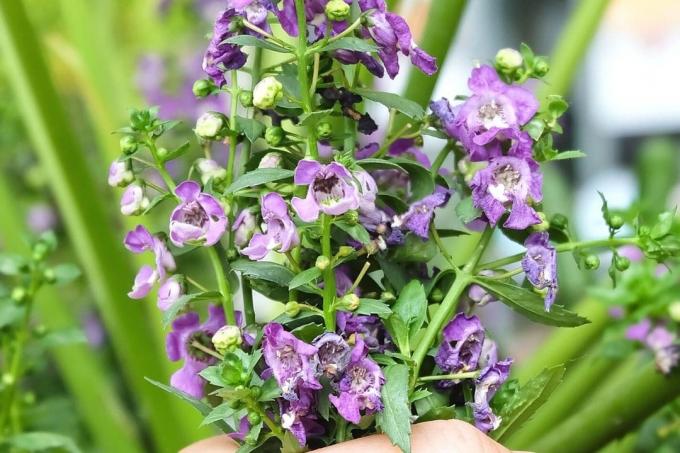
Table of Contents
- Cut with blossom
- Let the blossom stand
- Cut withered flowers
- Cut flowers correctly
- frequently asked Questions
Many garden herbs become inedible when they bloom. Other specimens benefit from a bloom. But how is it with sage? Read here whether you should cut off the flowers on the sage or not.
In a nutshell
- Sage blooms between May / June to July
- Edible flowers
- can, but do not have to be cut
- reduce leaf aroma
Cut with blossom
In principle, sage flowers can be cut off during the flowering period, but they do not have to be. Cutting has several advantages:
- Flowers edible and therefore usable for food
- stimulates growth
- the earlier cut, the better and stronger the leaf growth
- Prevention of uncontrolled sowing
- Leaf aroma develops more intensely
Tip: In order to avoid cutting out the sage flowers as much as possible, we recommend buying the “Dalmatian sage” variety (Salvia officinalis subsp. major). It is a subspecies of the real sage (Salvia officinalis), which blooms little or rarely, but has a much stronger leaf growth.
Let the blossom stand
The violet scented flowers fill every garden and balcony with color. This is the main reason why many hobby gardeners choose to leave it standing. This is entirely possible, because unlike numerous other herbs, the sage flowers do not give the leaves a bitter or inedible taste. These can still be used as culinary herbs. Only the aroma is reduced.

There are other advantages and disadvantages if the sage flowers are not cut off:
- Food source for numerous insects such as bees
- Self-sowing for wild growth ideal for Natural gardens
- no second bloom in autumn
- restricted leaf growth
- less immune system and consequently increased susceptibility to life-threatening damage from diseases and plant pests (due to higher nutrient consumption)
Cut withered flowers
Those who decide to let the sage flowers stand just postpone the pruning date. Cutting off wilted specimens is a must. Even in this state, the plant supplies the withered parts of the plant with nutrients. This means that there is less available for the leaves to develop and grow. The wilt often pulls and weakens the salvia severely. The following should be taken into account when cutting off already withered flowers on sage:
- Cutting off promotes the growth of the second flower around September
- then blooms well into autumn
- Always cut off withered things between mid-July and around the beginning of August
- The result is an improved supply of nutrients to the leaves and a better aroma

Tip: Ideally, withered flower stalks should be cut off before they are completely wilted. During flowering, the plant draws and stores significantly more nutrients, which can then be supplied to the leaves by pruning them early.
Cut flowers correctly
The right pruning technique depends on when and what the flower pruning should be used for:
| for consumption | Just pluck out flowers |
| to remove withered flowers | Pinch off the flower heads |
| to promote growth and aroma | Separate the flower stalks a hand width across the ground |
| to stimulate the second flowering period | Separate the flower stalks a hand width across the ground |
| to prevent blooming | Cut off the flower stalks in half |
frequently asked Questions
Yes. The leaves of healthy sage can also be separated during flowering. The further this has progressed, the lower the aroma content of the leaves. In the "worst" case, it is so low that the leaves are no longer suitable as a seasoning herb. It is therefore advisable to wait two to three weeks after flowering before harvesting the leaves so that the aroma intensifies - or you can cut off the sage flowers immediately after they have formed.
After removing the flower stalks, you can use the leaves for the kitchen as usual. Here, too, the aroma can be very minimal. You can also tie them up as bouquets, let them dry and hang them up as decorations or put them in a vase.
Yes and no. The “main task” of ornamental sage is to fill the environment with its flower color and its scent. Therefore, you should only cut them during the flowering period, when there is light growth or the plant is weakened due to a disease or pest infestation. However, the pruning at the onset of the wilt is important in order to be able to benefit from a second flowering in late summer / early autumn.


